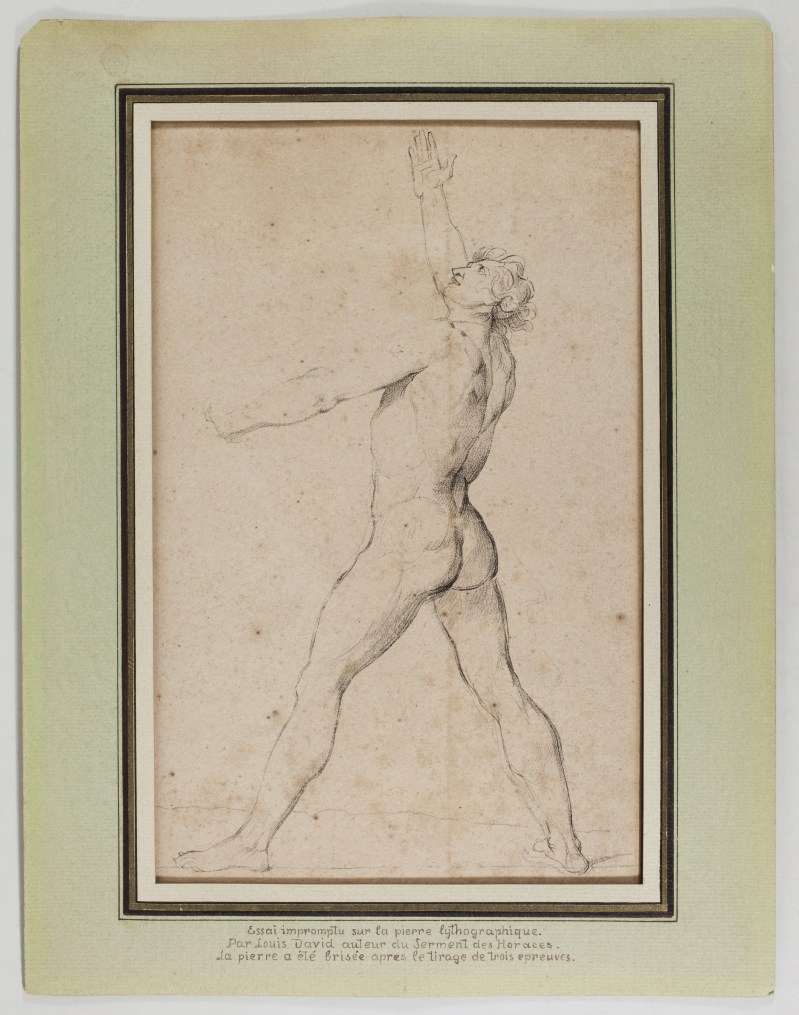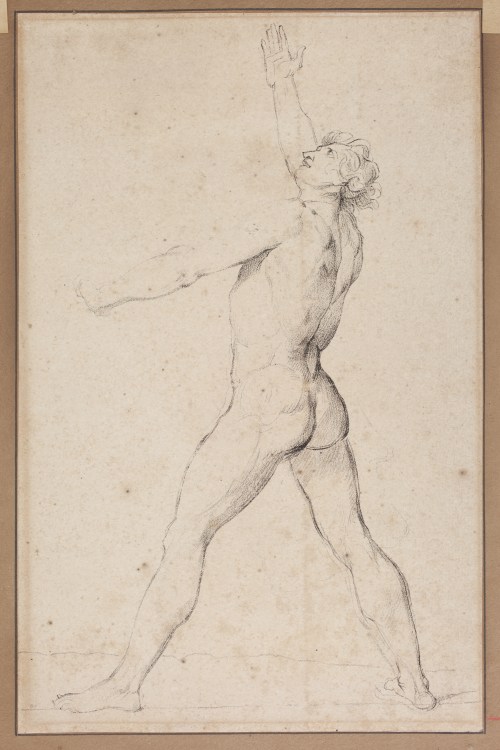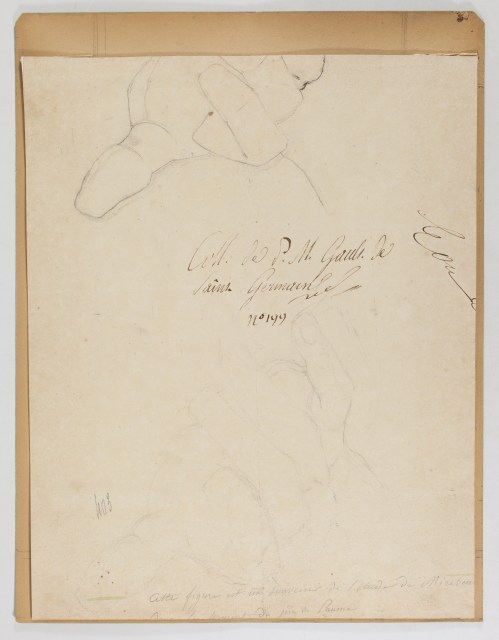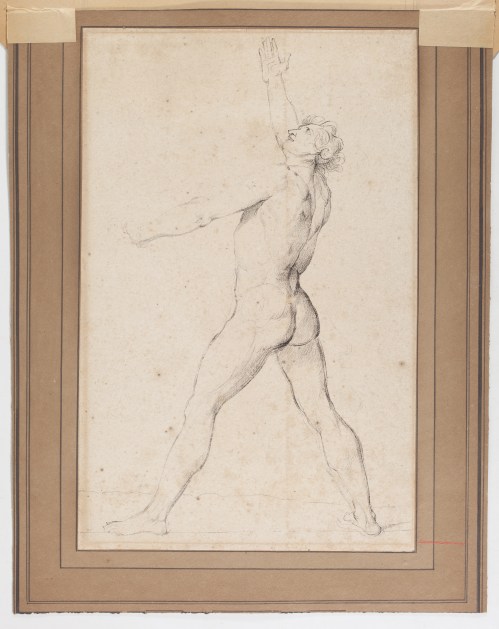Jacques-Louis DAVID : Étude pour la figure de Mirabeau nu debout, bras levé
Price: € 65 000
[Study for the figure of Mirabeau standing naked, arm raised]
in his famous painting Le Serment du Jeu de Paume
Lithograph, 252 x 171 mm (image). Bordes Dessins 20 (commentary), Rosenberg and Prat 114 (commentary).
Fine impression printed on laid paper pasted on board. Slight foxing at the opening of the passe-partout and a few foxmarks in the subject. A slight scratch. Sheet size: 264 x 171 mm. Annotation in pen and ink on the front of the passe-partout at the foot: Essai impromptu sur la pierre lythographique / Par Louis David auteur du Serment des Horaces / La pierre a été brisée après le tirage de trois épreuves. [Impromptu test on the lithographic stone / By Louis David author of the Serment des Horaces / The stone was broken after three impressions were printed]. Annotation on the verso of the mounting card in pen and ink: Coll. de P. M. Gault. de Saint Germain et n°199 and another annotation at foot, slightly cropped, in graphite: Cette figure est un souvenir de l'étude de Mirabeau pour le serment du jeu de Paume. [This figure is a souvenir of Mirabeau's study for Le Serment du Jeu de Paume.] The reverse also bears two hand sketches in graphite and a truncated annotation in pen and ink Eau... and the number 403 in graphite.
Provenance: Pierre-Marie Gault de Saint-Germain (1754 - 1842), painter, art historian and art critic, husband of the painter Anna Gault de Saint-Germain. His signature on the reverse.
This impression is listed in the Inventaire de ma collection artistique et de mes manuscrits inédits drawn up by Gault de Saint-Germain in 1839 (Paris, École des Beaux-Arts, ms 329). It is described as follows in his Notice des dessins de la Collection de Pierre Marie Gault de Saint Germain, littérateur, amateur: "David (Louis) auteur du Serment des Horaces etc. Essai lithographique d’après l’étude pour Mirabeau dans son tableau du Serment du jeu de paume, à Versailles. C’est la seule épreuve du crayon lithographique de ce célèbre artiste, qui a fait brisé [sic] la pierre, devant lui, après le tirage de deux épreuves. » [David (Louis) author of the Serment des Horaces etc. Lithographic test after the study for Mirabeau in his painting of the Serment du Jeu de paume, at Versailles. This is the only impression of the lithographic pencil by this famous artist, who had the stone broken in front of him after two impressions had been printed". (f° 435).
This impression was perhaps one of the drawings in the Gault de Saint-Germain collection sold on 19 March 1839 by the auctioneer Gitton de la Ribellerie. It is difficult to be certain, however, as the sale catalogue does not describe the lots in detail. Nor can the minutes of the sale in the auctioneer's archives at the Archives de Paris be used to identify precisely the few drawings by David mentioned in the various lots (Archives de Paris, Sect. III, D39 E3 5).
The lithograph is a fairly accurate reproduction of a lead pencil drawing, with a square setting, in the Musée Bonnat in Bayonne (AI 1899, NI 522; Bordes cat. no. 20). The sheet measures 281 x 207 mm and probably dates from 1791 (Rosenberg and Prat, p. 125).
It is interesting to note that Gault de Saint-Germain included this lithograph in his collection of drawings, considering it to be an autograph work by David from his "crayon lithographique".
Its mounting is typical of those used to display drawings, with its pen-and-ink frames, gold fillet, coloured wash and handwritten caption at the foot.
The existence of this lithograph was previously known only from the manuscripts of Gault de Saint-Germain, cited by Philippe Bordes and later by Pierre Rosenberg and Louis-Antoine Prat. In his exhaustive study Le Serment du Jeu de Paume de Jacques-Louis David, Philippe Bordes notes, with reference to the drawing conserved in Bayonne, that "According to P. Gault de Saint-Germain, David executed his only lithographic test after this figure and had the stone broken after only two impressions had been printed (Paris, Ecole des Beaux-Arts, ms 329, f° 435)". (Bordes, pp. 199-200, translated by us).
In their catalogue raisonné of the drawings of Jacques-Louis David, Pierre Rosenberg and Louis-Antoine Prat note that: "Bordes cites manuscript 329 from the École des Beaux-Arts in Paris, according to which (folio 435), according to Gault de Saint-Germain, David made an attempt at lithographing this figure. The stone was broken after the printing of two impressions, neither of which is known". (Rosenberg and Prat p. 125, translated by us).
In our research into this print, however, we discovered that the Musée Lansyer in Loches holds an impression of this lithograph (inventory number 2013.0.780, digitised print available online) which entered the collections of the future Musée Lansyer with the bequest by the painter and aquafortist Emmanuel Lansyer (1835 - 1893) to his home town of Loches. The bottom of the impression bears an annotation similar to ours: Mirabeau du serment du jeu de Paume. The sheet, signed or annotated David in graphite lower left, measures 322 x 207 mm.
If, as Gault de Saint-Germain indicates in the inventory of his collection, David had only two impressions printed, ours was his, the other being that of the Lansyer museum. However, the handwritten annotation on the passe-partout of our impression mentions three copies, so there may be another impression, which has yet to be located.
Apart from this "Essai impromptu sur la pierre lythographique", Jacques-Louis David did not engrave anything himself. He did, however, collaborate in the creation of the etching of the Serment du Jeu de Paume by Dominique-Vivant Denon: "we are currently working jointly on the etching of the painting of the Jeu de Paume", he wrote (quoted by Bordes, p. 85, translated by us). Dominique-Vivant Denon, who made many prints, was one of the first in France to take an interest in the fledgling art of lithography.
Michael Henker explains that "the invention of lithographic reproduction made in Munich in 1796/98 by the Bavarian Aloys Senefelder reached France as early as 1800 at the instigation of Anton André (1775-1842), a publisher of Offenbach's music of Huguenot origin. That same year, a lithographic printing works opened in Paris, and other European capitals soon followed suit. Napoleon himself showed great interest in the new reproduction process. He sent a commission of staff officers to Munich, including Dominique-Vivant Denon (1747-1825), Director General of French museums. The commission was initiated by Senefelder himself in his studio". (De Senefelder à Daumier, p. 9, translated by us). Lithography was soon used to reproduce master drawings.
It is very possible that Denon (or another pioneer of lithography, such as Nicolas-Henri Jacob, who was David's pupil) told David about this process and that David wanted to try out this revolutionary technique. The lithographic drawing of the nude figure of Mirabeau is in fact intended as a reproduction of the drawing, from which it takes most of the features, with a few exceptions (note, for example, the absence of the hat that Mirabeau is holding in his left hand in the drawing). The question of dating the lithograph remains open. It cannot, of course, have been produced when David was working on his project, in 1790-1791, or even when Denon made his etching version, around 1793-1794. On the other hand, it may date from the first or early second decade of the 19th century, as the existence of lithographic printing works in Paris made such an attempt possible. David may also have made it during his exile in Brussels, between 1816 and 1825, the date of his death, especially as he was once again concerned with reproducing his painting in the early 1820s.
The nude figure of Mirabeau is one of "three isolated studies for figures in the Serment, and all three show the nude figure". The other two figures are Barnave and Père Gérard [...]. “No doubt they were intended to be transferred to the large canvas, barely sketched out, where Barnave's head is one of the few (along with those of the other two figures mentioned above) to have been painted. [...] The isolated drawings of nudes for the Serment probably date from early 1791, around the time of the Fogg sheet [...]" (Jacques-Louis David, 1748-1825, p. 125, translated by us).
References :
Philippe Bordes : Le Serment du Jeu de Paume de Jacques-Louis David : le peintre, son milieu et son temps, de 1789 à 1792. Notes et documents des musées de France 8. Paris: Éditions de la Réunion des musées nationaux, 1983.
Michael Henker, Karlheinz Scherr and Elmar Stolpe: De Senefelder à Daumier: les débuts de l'art lithographique, 1988.
Pierre Rosenberg and Louis-Antoine Prat: Jacques-Louis David, 1748-1825: catalogue raisonné des dessins. Milan: Leonardo arte, 2002






